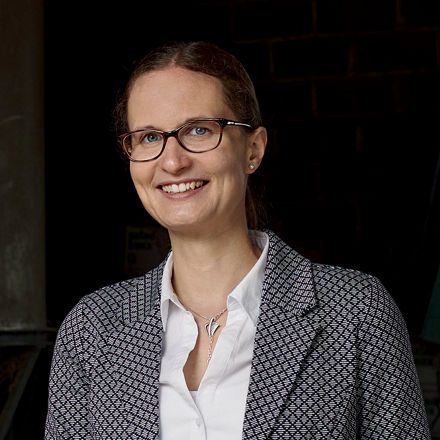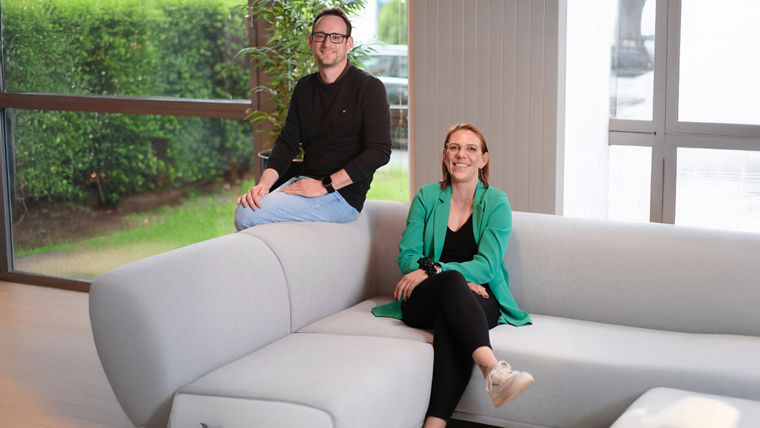For more than 100 years, nitrogen fertilizer on fields has ensured high crop yields. However, an oversupply can acidify the soil and displace important microorganisms. In the water, eutrophication leads to the growth of algae and ultimately to oxygen deficiency. It also increases the nitrous oxide content in the atmosphere, which exacerbates climate change.
To protect the environment, modern agriculture is therefore increasingly relying on microorganisms—for example by using nodule bacteria, known by experts as rhizobia. These rhizobia draw nitrogen from the air, convert it, and pass it on to plants.
Microorganisms are tomorrow’s superforce: They protect plants or allow them to grow, are good for the gut or the skin, and some even ward off their harmful counterparts or other pathogens. They are even used in technical applications such as “self-healing” concrete.
However, biologically active ingredients are often very sensitive. They must be processed into products that can survive storage, reach their point of use undamaged, and develop their full effect there. Experts call this further processing, in which components are mixed, formulation. This requires many steps, in which experts from Evonik’s Process Technology (VT) department, such as Max Braun, play a decisive role. They look for the right auxiliary agents and process steps for the perfect formulation: “Nowadays, it’s no longer enough to simply throw a finished material over the fence to the customer. We need complex solutions that are tailored to the customer and can be handled easily and well,” explains process engineer Braun, who is responsible for bioformulation topics at Process Technology. “Our competence platform brings together various specialist disciplines for the best formulation of biologically active ingredients.”

An example of how this collaboration works can be seen in the special rhizobia developed in the Agriculture Solutions program of Creavis, Evonik’s strategic research unit and business incubator. These rhizobia are biostimulants that improve the growth, resistance, and quality of plants and soil in a natural way.

»We benefit from the concentrated know-how in microbiology, agricultural science, chemical formulation, and process engineering«
Ines Ochrombel Program Manager at Creavis
Pooled expertise
However, their use is not trivial. Rhizobia, for example, are picky about who they supply with nitrogen. Peas, soybeans, and broad beans are among the plants that have benefited from rhizobia since time immemorial. However, the most important crops—cereals, canola, beet, and potatoes—do not interact with them. Evonik scientists are working to change that. There are already promising results for potatoes, corn, and wheat. “Our advantage is that we benefit from the concentrated know-how in microbiology, agricultural science, chemical formulation, and process technology,” says Ines Ochrombel, Program Manager at Creavis.
Microbiological knowledge is required to convert the bacteria into a storable and usable form. A suitable formulation is needed to keep the bacteria alive until they are used in the field. Comprehensive material and process knowledge is required as well: How are the tiny creatures stabilized, how are they made storable and ready for use?
“Biostimulants are a good example of how new products and markets are created when people from different specialist areas work together,” says process engineer Braun.


»We need physical and biological stability at the same time«
Jasmin Reiner process engineer at Evonik
Cultivate first, then harvest
Work begins at the Evonik Biotech Hub’s largest site in Halle-Künsebeck, not far from Bielefeld. Rhizobia, which can extract nitrogen from the air for cereals and potatoes, are isolated and characterized here. The microorganisms are then cooled before being sent to colleagues at the Biotech Hub in Hanau. There, they are cultivated in bioreactors—usually steel vats. “To ensure that this works optimally, we change the pH, the oxygen supply or the feed rate—the speed of the sugar supply—in order to achieve the best possible growth,” says Philipp Glembin, who is responsible for the Biotech Hub’s laboratory team.
Once fermentation is complete, the microorganisms are centrifuged and thus concentrated. Bioprocess engineers refer to this as harvesting the bacteria grown in the bioreactor. The milky soup they obtain is far from ready for use by the customer; the actual product still requires formulation. To determine the formulation, the soup first has to go to Process Technology.
“With formulation, just like with a cake, everything depends on the right ingredients, the perfect quantity, and the concentration,” says Jasmin Reiner, a process engineer who specializes in bioformulation. The experts at Process Technology look for the right auxiliary agents and technologies for the perfect mix. “We need physical and biological stability at the same time.”

Putting the rhizobia into temperature-independent dormancy is crucial task for the specialists. This is necessary in order to keep the microorganisms viable for longer and thus permanently preserve the product at room temperature.
To do this, they remove the moisture from the milky white liquid. A common technique for this is spray drying, in which a solution is atomized into fine droplets and then dried by a stream of hot air to produce a powder. However, it’s all about nuances. If too little water is removed, the bacteria continue to metabolize and die due to a lack of nutrients—long before they are used in the field.
However, the powder should not be too dry. “If we remove all the water, the cultures die too,” says Reiner. “We have to find just the right balance so that the cultures live but are dormant.”

Five Steps

Nothing works without additives
The experts at Evonik also consider many other customer requirements. If biostimulants are used in agriculture, for example, it is important that they can be mixed with water and sprayed on the field without clogging the nozzles of the agricultural machinery. They must also be compatible with the crop protection products that a farmer is already using. “We can’t expect someone to drive across the field twice or even buy new machinery just to use our biostimulants,” says Stefan Gilch, Project Manager for Agricultural Solutions at Creavis. “So we have to align ourselves with the end customers’ equipment.”

To meet these requirements, the process engineers add a silicate carrier material—Sipernat® specialty silica—to the rhizobia solution that is fed into the spray dryer. With its help and the various spray drying settings, the process engineers can influence both the size and the properties of the particles in the powder, which end up small and round so that the nozzles of the sprayers do not clog.
To ensure that the rhizobia are not damaged during storage and on the way to the field, they are also coated with a special sugar during spray drying. This coating protects the microorganisms from environmental influences such as light, moisture, and oxygen, thus increasing their stability. As soon as a farmer mixes the finished formulation with water, he wakes up the microorganisms and the sugar coating dissolves at the same time. The sugar can then serve as food for the microorganisms. “We copied this from nature,” explains Braun.
But the process isn’t finished yet. Before the biostimulants are ready for use, they have to undergo a further process engineering step: dispersion. The particles from the spray drying process are mixed with a special anhydrous liquid consisting of various Evonik additives. “We draw on the broad expertise and existing products from our businesses,” says Reiner. Products from the Break-Thru portfolio are used as biodegradable carrier liquids and as dispersing additives for the finest possible distribution. In addition, Aerosil® fumed silica ensures that the particles are kept in suspension and do not settle on the bottom of the container.

A Break-Thru product also performs another important task as an adjuvant: It ensures that the microorganisms arrive at their site of action and remain there, even when it rains. “If we simply sprayed the biostimulants onto a plant, the drops would remain on the top of the leaves or be washed off by the rain,” explains project manager Gilch. The effect would be zero. Thanks to the adjuvant, the biostimulants spread out over a large area of the leaf and also spread to its underside, where they reach the inside of the leaf through tiny respiratory openings (stomata). There they are protected from wind and weather and supply the plant with nitrogen from the air.
Finding the sweet spot
All these processes and requirements are taken into account at Process Technology. “We know that we need staying power,” says Reiner. Figuring out the right combination of microorganisms, materials, and stabilizers for each customer’s requirements is the real challenge. Individual parameters such as temperature, pressure or throughput rates are changed step by step. “This is how you make progress,” she adds. Her colleague Braun describes the balancing of drying speed and temperature, auxiliary agents and stabilizers as “finding the sweet spot.” Still, the process technology experts do not start from scratch every time. “We have the experience to choose the best solution from the many options available,” says Braun. “The rest is fine-tuning.”
However, this fine-tuning is what counts. After all, farmers expect the microorganisms they want to supply their crops with nitrogen to still be effective even after months of storage. Creavis has mastered this challenge in cooperation with Evonik’s Process Technology department. Test results show that the effectiveness of rhizobia is just as high after two years in storage at room temperature as it is after two weeks.

The Almost-All-Rounders

Farmers aren’t Evonik’s direct customers. “We work together with companies such as Agravis and Helm from the agriculture and chemical sectors,” says project manager Gilch. Agravis is conducting field trials to investigate the effect of various biostimulants on potatoes and, in cooperation with Helm, on wheat and corn. The effect is substantial. In field trials last year, potato yields were increased by an average of 28 percent. The increase is lower for wheat and corn. “We haven’t found the best way yet,” says Stefan Gilch. He is currently using different fields to test whether it is better to apply the biostimulants once or twice. And at what stage of plant growth?
The first biostimulants that can be used stably by farmers thanks to Evonik technology and materials will be launched on the market in 2027. “We are already preparing everything for this launch,” says Creavis program manager Ines Ochrombel. “Our innovation has the potential to become a building block in the agriculture of the future.”



